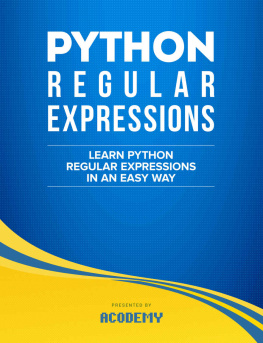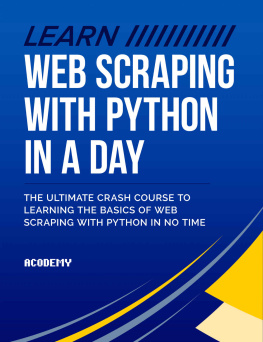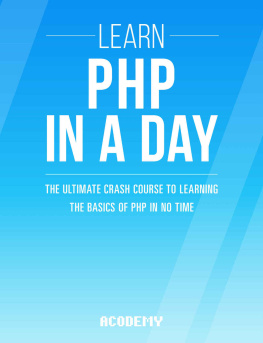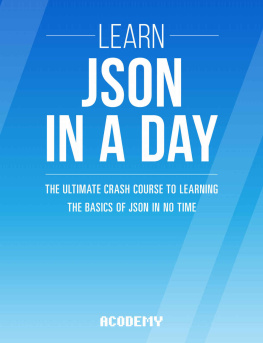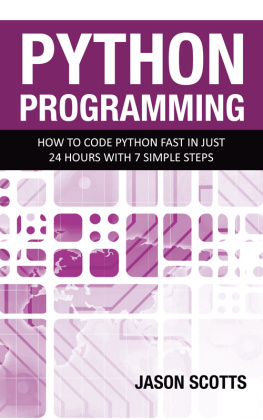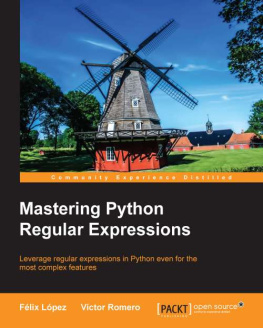Acodemy - Python: Learn Python Regular Expressions FAST! : The Ultimate Crash Course to Learning the Basics of Python Regular Expressions In No Time
Here you can read online Acodemy - Python: Learn Python Regular Expressions FAST! : The Ultimate Crash Course to Learning the Basics of Python Regular Expressions In No Time full text of the book (entire story) in english for free. Download pdf and epub, get meaning, cover and reviews about this ebook. year: 2015, genre: Computer. Description of the work, (preface) as well as reviews are available. Best literature library LitArk.com created for fans of good reading and offers a wide selection of genres:
Romance novel
Science fiction
Adventure
Detective
Science
History
Home and family
Prose
Art
Politics
Computer
Non-fiction
Religion
Business
Children
Humor
Choose a favorite category and find really read worthwhile books. Enjoy immersion in the world of imagination, feel the emotions of the characters or learn something new for yourself, make an fascinating discovery.
Python: Learn Python Regular Expressions FAST! : The Ultimate Crash Course to Learning the Basics of Python Regular Expressions In No Time: summary, description and annotation
We offer to read an annotation, description, summary or preface (depends on what the author of the book "Python: Learn Python Regular Expressions FAST! : The Ultimate Crash Course to Learning the Basics of Python Regular Expressions In No Time" wrote himself). If you haven't found the necessary information about the book — write in the comments, we will try to find it.
Acodemy: author's other books
Who wrote Python: Learn Python Regular Expressions FAST! : The Ultimate Crash Course to Learning the Basics of Python Regular Expressions In No Time? Find out the surname, the name of the author of the book and a list of all author's works by series.
Python: Learn Python Regular Expressions FAST! : The Ultimate Crash Course to Learning the Basics of Python Regular Expressions In No Time — read online for free the complete book (whole text) full work
Below is the text of the book, divided by pages. System saving the place of the last page read, allows you to conveniently read the book "Python: Learn Python Regular Expressions FAST! : The Ultimate Crash Course to Learning the Basics of Python Regular Expressions In No Time" online for free, without having to search again every time where you left off. Put a bookmark, and you can go to the page where you finished reading at any time.
Font size:
Interval:
Bookmark:
By Acodemy
Copyright 2015
PYTHON REGULAR EXPRESSIONS
The ultimate crash course to learn Python Regular Expressions FAST!
Disclaimer
The information provided in this book is designed to provide helpful information on the subjects discussed. The authors books are only meant to provide the reader with the basics knowledge of a certain topic, without any warranties regarding whether the student will, or will not, be able to incorporate and apply all the information provided. Although the writer will make his best effort share his insights, learning is a difficult task and each person needs a different timeframe to fully incorporate a new topic. This book, nor any of the authors books constitute a promise that the reader will learn a certain topic within a certain timeframe.
All rights reserved. No part of this book may be reproduced or transmitted in any form or by any means without written permission from the author and publisher.
This book is written to guide those who are passionate to learn how to use Python Regular Expressions. It has been written to help those who intend to learn basic and complex tools of Python Regular Expressions.
Table of Contents
Regular Expressions
History of regular expressions
Most important concepts related to regular expressions
A brief overview
Backslash in string literals
Building blocks for Python Regular Expressions
Module Operations
Escaped metacharacters in regexes
Character classes
Predefined character classes
Repeating things
Alternation
Quantifiers
Greedy as well as reluctant quantifiers
Possessive Quantifiers
Boundary Matchers
Module Contents
Regular Expression Objects
Expressions with Python
Backreferences
Named groups
Atomic groups
Specialized cases with groups
Look Ahead
Look Behind
Look around and groups
The RegexBuddy Tool
Going through the Python regular expression engine
Backtracking
Recommendations for Optimization
Extraction of general portions in alternation
Shortcut to alternation
Be specific
Not being greedy
Comparison between python and others
What is different in the third version of Python?
Not employing the DOTALL flag while finding multi-line strings
Not employing the MULTILINE flag while finding multi-line strings
Not making repetitions non-greedy
Making searches case-sensitive
Not compiling regexes
search() and match() comparison
Creating a Phonebook
Data Munging
Discovering all Adverbs
Discovering all Adverbs and their Locations
Chapter Objective:
The main objective of this chapter is to make the readers familiar with what a regular expression is. The chapter covers most of the basic concepts related to regular expressions. First of all, a basic explanation of regulation expressions is given and then the history so that the reader has an idea of how regular expressions evolved with time and their importance in the present scenario. The next part gives an overview of the most basic terms related to regular expressions like literal characters, character classes, back references, etc. In the end, an exercise to test what the reader has gained from the chapter has been given.
Regular expressions are also termed as regexes, REs or regex patterns. They are basically a minute, extremely specialized programming language implanted inside Python and the re module is used for making them available. By employing this tiny language, you specify the rules for the probable strings set which you wish to match. Such a set can contain e-mail addresses, English sentences, or TeX commands, or whatever you wish. You may then ask questions like Is this string matching the
Pattern? You may also employ Regular Expressions for modifying a string or splitting it apart in a variety of ways.
RE patterns have been compiled into a sequence of bytecodes. The execution of the byte code takes place by a matching engine that is written in C language. It might be required to give precise attention to how the engine will be executing a particular Regular Expression, and write the Regular Expression in a particular way for creating to bytecode which runs faster.
REs can be considered as text patters describing the form string of text should possess. A number of functions can be accomplished by employing regular expressions. The chief among them being the following:
Find out particular pattern appearance in a specific text. To exemplify, it is possible to examine whether a word hard is present in a document by employing only one scan.
Extraction of a particular part of a text. To exemplify, the extraction of a street number of any address.
Replacement of a particular part of text such as altering the color of a specific text to violet.
Breaking down a text in to chunks by employing a punctuation, etc.
Regular expressions gained fame in the late 1960s. The maiden appearances of Res in programming can be credited to develop Kleene's notation into the Quick Editor as a way to for matching various patterns in several text files. For speed, the implementation of regular expression was performed by using JIT to IBM 7094 code on the Compatible Time-Sharing System. Ken Thompson.
A comparatively more complex Res came into picture in Perl in the late 1980s. They were actually derived from a regex library. In the present scenario, Res are largely backed in text processing programs, programming languages and various other programs. Re back is an element of the standardized library of various programming languages which comprise Python, etc. and is created into the syntax of others which comprise Perl and ECMA Script. Employments of Re functionality are mostly known as a regular expression engine, and various libraries are there for reuse.
Res are universal. They are present in the most novice Javascript framework and can also be traced in the UNIX tools of the 1970s. Any modern programming language is incomplete if it does not back Res.
Though they are found in various languages, they are not found in the toolkit of the current coders. The difficult learning curve offered by them can be one of the causes of this. Being an expert in Res is not so easy and they are very complicated to read when not written appropriately.
Once you read this book, you will be able to learn the most competent practices while composing regular expressions to ease the reading procedure. Though Res are present in the newest and the most effective programming languages presently, their history can be traced back to 1943 when a logical calculus of the concepts existing in nervous activity was released by Warren McCulloch and Walter Pitts. This research was actually the starting point of the regular expressions and offered the maiden mathematical model of a neural network. In the year 1968, a renowned contributor of computer science (Ken Thompson) considered the findings of Kleene and further expanded it, publishing his works in the Regular Expression Search Algorithm titled paper. His contributions were not limited by just a single paper. He encompassed support for these Res in his version of Quick Editor.
Other remarkable milestones worth mentioning here are the issue of the maiden non-proprietary library of regex by Henry Spence and after that, the development of the Perl by famous computer science contributor, Larry Wall. The implementation in Perl was taken to another step and contributed a number of modifications to the actual RE syntax thereby making the famous Perl flavor. A number of the implementations that followed in other languages or tools are depended on the Perl flavor of Re.
Font size:
Interval:
Bookmark:
Similar books «Python: Learn Python Regular Expressions FAST! : The Ultimate Crash Course to Learning the Basics of Python Regular Expressions In No Time»
Look at similar books to Python: Learn Python Regular Expressions FAST! : The Ultimate Crash Course to Learning the Basics of Python Regular Expressions In No Time. We have selected literature similar in name and meaning in the hope of providing readers with more options to find new, interesting, not yet read works.
Discussion, reviews of the book Python: Learn Python Regular Expressions FAST! : The Ultimate Crash Course to Learning the Basics of Python Regular Expressions In No Time and just readers' own opinions. Leave your comments, write what you think about the work, its meaning or the main characters. Specify what exactly you liked and what you didn't like, and why you think so.

